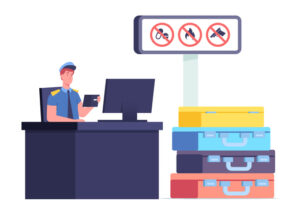Traveling to the United States under the Visa Waiver Program (VWP) with an Electronic System for Travel Authorization (ESTA) approval can be an exciting prospect. However, there are cases where travelers face the unexpected situation of having ESTA approved but denied entry to the U.S. In this blog post, we delve into the complexities of this scenario and provide a comprehensive guide to help ESTA applicants understand the reasons behind such denials and how to avoid them.
This comprehensive guide covers the following topics:
- The ESTA Journey: From Application to Approval
- The Unexpected Twist: Denied Entry Despite ESTA Approval
- Underlying Reasons for Entry Denial After ESTA Approval
- Coping with Denied Entry: What Can You Do?
- Avoiding Entry Denial: Best Practices for ESTA Applicants
The ESTA Journey: From Application to Approval
The Electronic System for Travel Authorization (ESTA) is a crucial part of the Visa Waiver Program (VWP), enabling citizens from eligible countries to travel to the United States without obtaining a traditional visa. Understanding the process of acquiring ESTA approval is essential for hassle-free travel to the U.S. In this blog post, we will take you through the ESTA journey, from application to approval, and shed light on the significance of this travel authorization.
Recap of ESTA and Application Process
 The ESTA is an online system that determines the eligibility of travelers to enter the U.S. under the VWP. Applicants must submit their personal information, travel details, and answer eligibility-related questions through the ESTA website. The application process is straightforward and typically involves providing basic biographic information and passport details.
The ESTA is an online system that determines the eligibility of travelers to enter the U.S. under the VWP. Applicants must submit their personal information, travel details, and answer eligibility-related questions through the ESTA website. The application process is straightforward and typically involves providing basic biographic information and passport details.
The popularity of ESTA has grown significantly over the years, with millions of travelers benefiting from this streamlined process. According to recent data, there are millions of ESTA approvals granted annually, indicating the program’s success in facilitating legitimate and secure travel to the U.S. These numbers highlight the importance of ESTA as a convenient and efficient travel authorization method for eligible travelers.
Once the ESTA application is submitted, most applicants receive approval within minutes. Approved ESTA authorization is valid for two years or until the passport expires, whichever comes first. During this period, travelers can visit the U.S. multiple times for stays of up to 90 days per visit, for business, tourism, or transit purposes.
The Unexpected Twist: ESTA Approved but Denied Entry
The Electronic System for Travel Authorization (ESTA) has undoubtedly simplified travel to the United States for eligible travelers. However, there are instances where travelers face an unexpected twist – being denied entry to the U.S. despite having an approved ESTA. In this blog post, we delve into the reasons behind such situations and shed light on the frequency of these occurrences.
Exploring Denied Entry Situations
 Entry denial despite ESTA approval can happen due to various reasons. One common cause is that while ESTA grants travel authorization, it does not guarantee entry into the U.S. The U.S. Customs and Border Protection (CBP) officers at the port of entry hold the final authority to allow or deny entry after conducting additional checks. If they find discrepancies in the traveler’s purpose of visit, personal information, or travel history, they may deny entry.
Entry denial despite ESTA approval can happen due to various reasons. One common cause is that while ESTA grants travel authorization, it does not guarantee entry into the U.S. The U.S. Customs and Border Protection (CBP) officers at the port of entry hold the final authority to allow or deny entry after conducting additional checks. If they find discrepancies in the traveler’s purpose of visit, personal information, or travel history, they may deny entry.
While denied entry cases are relatively rare compared to approved ESTA entries, they still occur. Statistics reveal that a small percentage of travelers face such situations annually. However, it is essential to note that ESTA denial is not always due to fraudulent intentions or inaccurate information. Sometimes, it can be the result of genuine misunderstandings or mistakes in the application process.
Underlying Reasons for Entry Denial After ESTA Approval
Despite having an approved Electronic System for Travel Authorization (ESTA), travelers may still face the unexpected disappointment of ESTA approved but denied entry to the United States. Understanding the underlying reasons behind such entry denials is essential for all prospective travelers. Below is a bullet point list of the most popular reasons for denied entry with an approved ESTA:
Inconsistencies or falsehoods in the application
- Changes in circumstances between application and entry
- Security or health concerns
- Misunderstanding of ESTA rules
Discrepancies in Application
The U.S. Customs and Border Protection (CBP) scrutinizes ESTA applications carefully. Any inconsistencies or inaccurate ESTA information in the application, intentionally or inadvertently, can lead to entry denial.
Changes in Circumstances
Circumstances may change between ESTA application and actual travel, such as employment status or travel purpose. If these changes raise suspicion or deviate from the original application, entry may be denied.
Security or Health Concerns
Security and health are top priorities for the U.S. government. If a traveler is flagged as a security risk or poses ESTA health concerns, entry may be denied for public safety reasons.
Misunderstanding of ESTA Rules
Some travelers may unintentionally violate ESTA rules, such as exceeding the allowed stay or engaging in unauthorized work. These misunderstandings can lead to entry denial.
Coping with Denied Entry: What Can You Do?
Being denied entry to the United States, even with an approved ESTA, can be a distressing and confusing experience. However, all hope is not lost. If you find yourself in such a situation, here is a step-by-step guide on how to cope with denied entry:
- Stay Calm and Cooperate: While denial can be disheartening, it is crucial to remain calm and cooperate with the Customs and Border Protection (CBP) officers. Avoid any confrontations and provide truthful answers to their questions.
- Ask for Clarification: Politely ask the CBP officers for the specific reason for the denial. Understanding the cause can help you address any misunderstandings or discrepancies.
- Seek Legal Advice: If you believe the denial is unjustified or based on a misunderstanding, consider seeking legal advice from an immigration attorney. They can guide you on the appropriate steps to take.
- Request Reconsideration: In some cases, you may have the option to request reconsideration. The CBP provides a process for submitting additional information to support your case.
- Reapply with Corrected Information: If the denial was due to inconsistencies in your application, you may correct the information and reapply for ESTA or update ESTA. Ensure all details are accurate and truthful.
- Consider Applying for a Visa: If ESTA is not an option, you might explore obtaining an appropriate nonimmigrant or immigrant visa. Each U.S. visa category has specific requirements, so research which one aligns with your circumstances.
- Reevaluate Travel Plans: Take the time to reevaluate your travel plans. If entry is not possible at the moment, consider postponing your trip or exploring alternative destinations
Avoiding Entry Denial: Best Practices for ESTA Applicants
As an international traveler planning a trip to the United States, obtaining an approved ESTA is a significant milestone. However, it’s essential to remember that an ESTA approved but denied entry is still possible and ESTA does not guarantee entry into the country. Entry denial, though relatively rare, can still occur for various reasons. To help you navigate the process and increase your chances of a successful entry, consider the following best practices and common mistakes to avoid:
- Accurate and Truthful Information: Provide precise and truthful information when filling out your ESTA application. Any inconsistencies or false details could lead to entry denial.
- Review Your Application: Before submitting your application, review it thoroughly to ensure all information is correct. Double-check your passport details, travel dates, and personal information.
- Comply with ESTA Requirements: Familiarize yourself with the ESTA requirements and eligibility criteria. Ensure you meet all the necessary conditions before applying.
- Keep Your Travel Plans Clear: Be transparent about your travel plans, including the purpose of your visit and intended duration of stay. Inconsistent travel intentions might raise concerns.
- Avoid Last-Minute Changes: Avoid making significant changes to your travel plans after your ESTA approval. Last-minute modifications might lead to confusion at the port of entry.
- Stay Informed: Keep yourself updated on any changes to the U.S. immigration policies or ESTA regulations. These updates can impact your entry process.
- Seek Legal Advice if Necessary: If you have concerns or specific immigration-related questions, consider seeking guidance from an experienced immigration attorney.
- Monitor ESTA Status: Even after obtaining ESTA approval, periodically check its validity status. ESTA can be revoked or cancelled for various reasons. You can also verify or check ESTA status on our website.